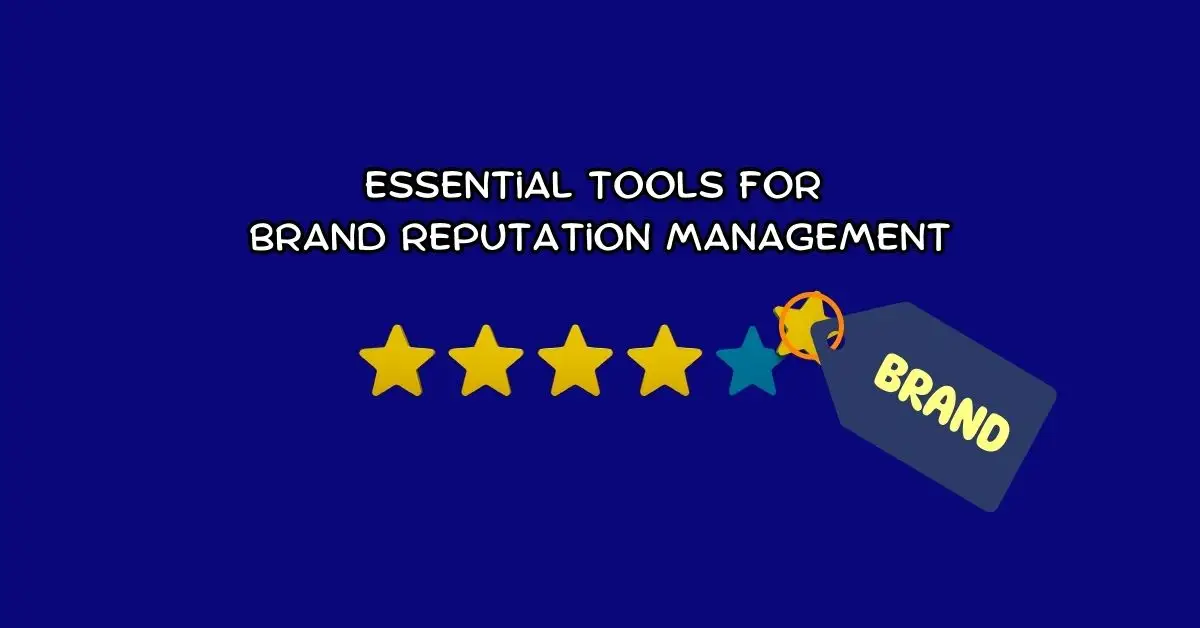
Essential Tools for Brand Reputation Management
Have you ever considered what a single reputational crisis could cost your company? Brand reputation management faces a serious problem where companies risk devastating consequences to their bottom line if they aren't careful.
If you're reading this, odds are you work in marketing or communications. You either manage reputation for clients or handle it in-house. You implement best practices, set strategy, and help colleagues or customers protect their brand image. This guide presents the critical tools needed by marketing and communications professionals for protecting and enhancing the brand reputation in real-time.
Key Takeaways
- Understand what a brand is and the importance of brand reputation management.
- Learn why marketers care about reputation management tools.
- Know the key tools for reputation management including monitoring, review management, social listening, sentiment analysis, etc.
- Recognize best practices for implementing reputation management tools effectively and the implementation of the framework.
- Explore case studies of brands like Starbucks and Nike that successfully managed crises and strengthened their reputation.
What is a Brand and Why Brand Reputation Management is Essential?
A brand isn't just a logo or tagline of your company. It's what every customer perceives and experiences. Your Brand is the promise you make to your customers and the retention of that expectation. It's the cumulative impact of every interaction such as the effects of advertising, sales, customer service, and even product quality.

Brand reputation management is all about strategically monitoring and protecting your company's corporate image. Nowadays, everything is digital, where information spreads quickly across social media and review platforms. This is where a company's reputation can be damaged in minutes, but may take years to repair.
This is why brand reputation management is crucial, which directly impacts your bottom line. Research consistently shows that companies with strong positive reputations:
- Command premium pricing
- Attract talents who have adequate skills
- Recover more quickly from crises
- Enjoy greater customer loyalty and retention
- Experience higher stock valuations (for public companies)
On the flip side, reputational damage will lead to market boycotts, lost partnerships, regulatory scrutiny, and a large downside on revenue. The 2023 Weber Shandwick Reputation Study declares that 63% of a company's market value is attributed to its reputation.
Why Should Marketers Care About Reputation Management Tools?
According to stats, every minute thousands of tweets, 695,000 Instagram stories, and over two thousand reviews are written, any of which could mention your brand. This creates 2.5 quintillion bytes of data daily, which makes manual brand monitoring almost impossible.

Without specialized tools, critical mentions slip through the cracks. Consider United Airlines' 2017 passenger removal video incident. They learned this lesson the hard way. The video was circulating for over 12 hours, gathering millions of views before their PR team became aware. This incident ultimately cost them $1.4 billion in market value and years of reputational recovery.
Reputation management tools provide essential monitoring capabilities that prevent crises and deliver valuable insights on sentiment and competitive positioning. The best approaches combine digital monitoring with consistent physical branding.
Companies like Sugarcoat help businesses reinforce their reputation through quality promotional merchandise that complements their online reputation efforts. Without proper tools, marketers operate with dangerous blind spots that can compromise years of brand building.
Evolution of Reputation Management
Brand reputation management has transformed from simple press clipping services to a sophisticated digital discipline. Three key shifts define this evolution:
- First, companies moved from reactive to proactive monitoring, which helps them identify potential issues before they escalate. This transition aids in reducing crisis response times by 72% for organizations using advanced tools.
- Second, manual analysis gave way to automated intelligence, with AI platforms processing millions of data points in seconds, expanding capabilities while reducing required resources by 60%.
- Finally, reputation management progressed from tracking isolated metrics to measuring business impact. This approach connects reputation directly to sales, retention, and share value with leading companies showing 31% higher market valuations attributable to their reputation initiatives.
The Essential Brand Reputation Management Toolkit
Effective reputation management now requires an integrated approach using specialized tools. Let's view the comprehensive toolkit that high-performing companies deploy to protect and retain their brands:
| Category | Purpose | Example Tools |
|---|---|---|
| Monitoring & Alert Platforms | Early-warning system to detect brand mentions | Google Alerts |
| Review Management Tools | Centralizes and tracks customer feedback for better retention | Birdeye |
| Social Listening Solutions | Identifies broader conversations and sentiment shifts | Brandwatch |
| SEO Tools | Manages search rankings to prevent negative content from dominating | Ahrefs, SEMrush, Smart Tools AI |
| Content Management Systems (CMS) | Enables quick publishing of responses and corrections | WordPress |
| Customer Experience Analytics | Detects service/product issues before they harm reputation | Qualtrics |
| Crisis Management Dashboards | Helps teams coordinate messaging during reputation threats | Meltwater |
| Sentiment Analysis | Provides deeper emotional context in brand mentions | Lexalytics |
| Competitor Benchmarking | Assesses brand reputation relative to industry peers | SEMrush |
| Integrated Reporting | Links reputation efforts to business impact and ROI | Sprout Social |
The most effective organizations don’t just collect tools, rather they strategically integrate them. Research shows that companies with a well-coordinated tool stack respond to potential threats three times faster and reduce crisis management costs by 40%.
Best Practices for Implementing Reputation Management Tools
Having the right tools is great, but using them effectively is what truly matters. Here are some ways to ensure you get the most out of your reputation management stack:
- Choose the Right Tools: No logging with a bunch of tools at the same time, with loaded features. Just pick tools exactly for your need.
- Train Your Team: The most effective tools won't be beneficial unless the employees are knowledgeable about their use. A properly trained team responds more quickly to crises.
- Automate Wisely: Use automation for monitoring and alerts. However, human oversight is crucial for responses.
- Integrate Your Tools: Integrate your monitoring, review management, and SEO tools into one system.
- Regularly Review Performance: Set and track KPIs like sentiment shifts and response times to measure effectiveness.
Implementing Your Reputation Management Framework
To make the most of your reputation management tools, you need a clear strategy. Here’s how to implement them effectively (See the Flowchart Example):
Case Studies: Companies That Mastered Brand Reputation Management
Successful brands understand the critical importance of reputation management. Let's look at two companies that turned potential crises into brand-building opportunities:
1) Starbucks: Handling a Racial Bias Incident
When two Black men were arrested at a Philadelphia Starbucks in 2018, the company faced serious backlash. Starbucks' response aligned with its core values, as seen in many strong mission statements. Rather than hiding behind corporate statements, they took bold action by:
- Closing 8,000 stores for racial bias training.
- Issuing a genuine public apology and engaging with affected communities.
- Completely revamping their store policies to prevent similar incidents.
2) Nike: Leveraging Controversy for Growth
When Nike featured Colin Kaepernick in their 2018 "Just Do It" ad campaign, they knew it would spark debate. Colin was the one kneeling during the anthem in protest of social injustice. While some burned Nike products in protest, the company stood firm in their decision. The results?
- A 31% sales increase in the days following the campaign launch.
- Strengthened loyalty among their core young, urban customer base.
- A reinforced brand identity built on bold values and authentic positioning.
Both cases show how strong brand reputation management can turn challenges into long-term brand strength. Apart from just surviving, these companies thrived by remaining true to their brand values.
Wrapping Up
Brand reputation management is an invaluable aspect for every company. It needs careful attention and sophisticated tools. When reputation challenges hit, your response matters more than the crisis itself. Companies that combine the right monitoring technologies with authentic values survive crises easily and get opportunities for deeper customer connection.
FAQs
Q1: How often should I audit my reputation management tools?
Conduct a comprehensive audit every 6 months to assess any gaps and redundancies along with new market offerings. Since technology changes much faster, frequent evaluation confirms that you are using the right tools that fit specific needs.
Q2: How can small businesses with limited budgets approach reputation management?
Start with free tools like Google Alerts and social media native analytics, then invest in specialized tools as the business grows. For small companies, consistent monitoring and responses are more crucial than having the expensive technology.
Explore Related Posts
https://smarttoolsai.com/post/sales-prospect-evaluation-criteria
.webp)